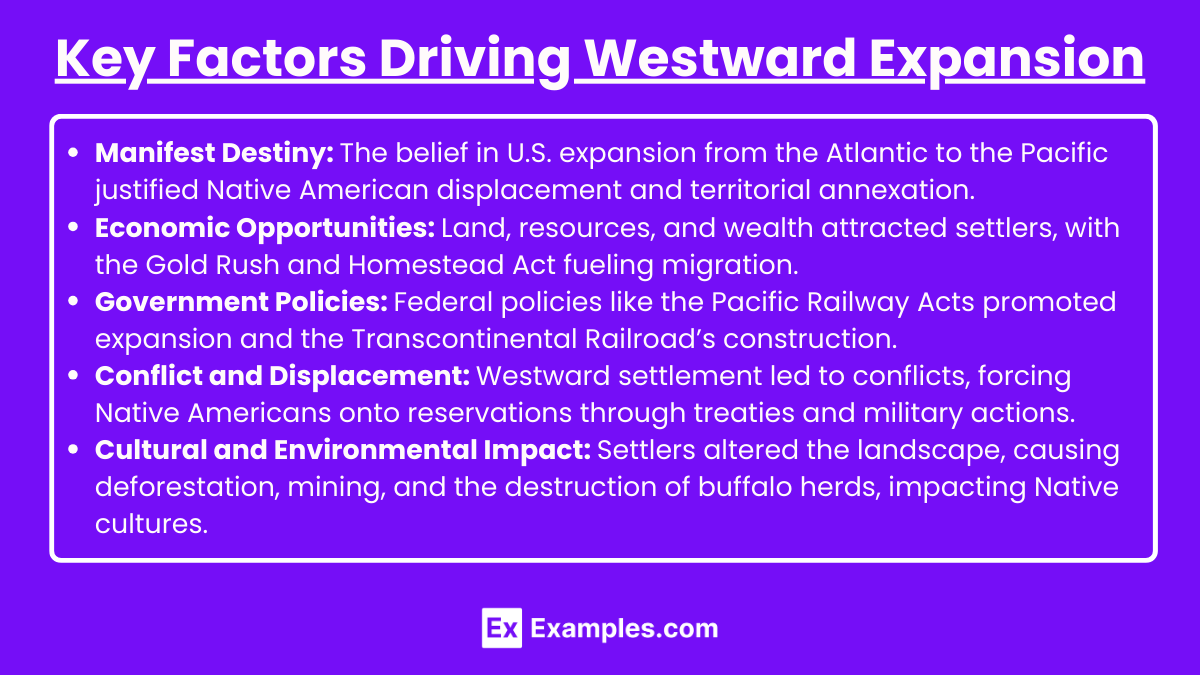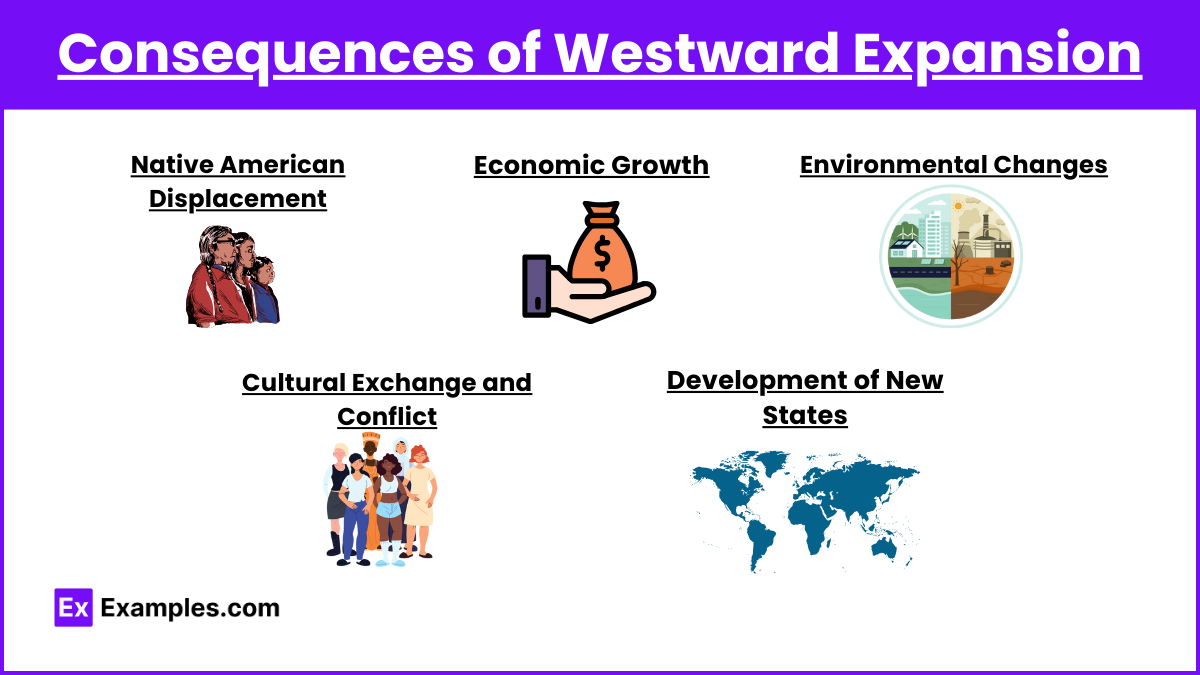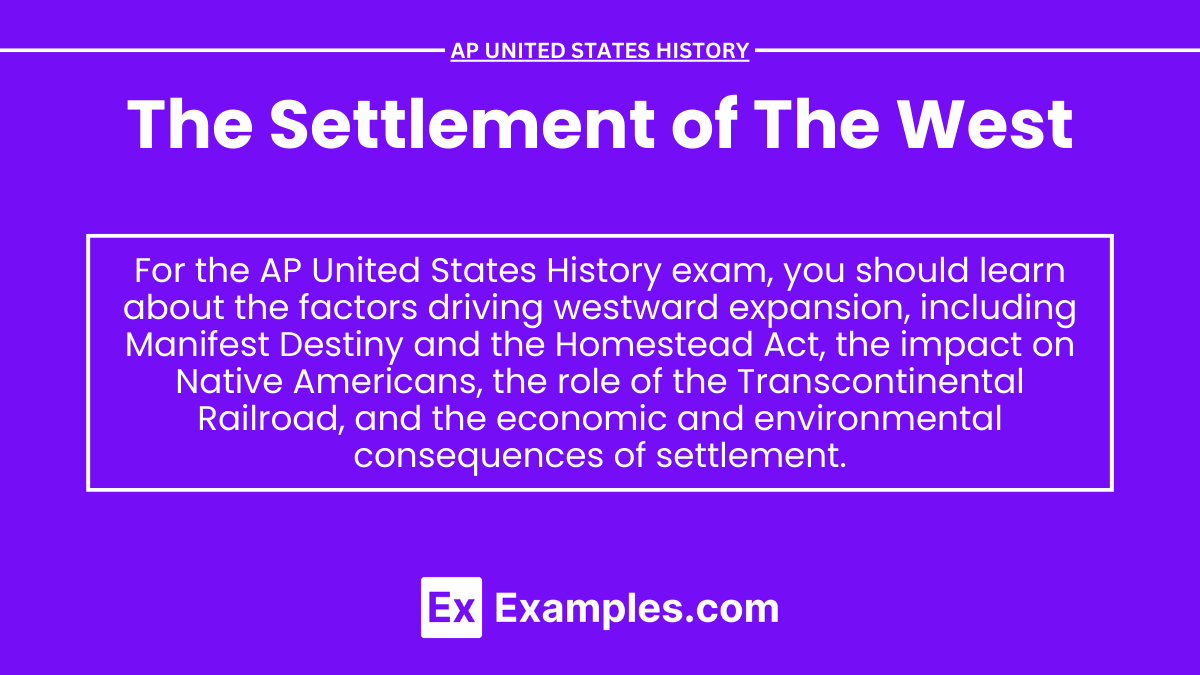In AP United States History, the Settlement of the West refers to the period during the 19th century when Americans expanded westward, driven by the ideology of Manifest Destiny, economic opportunities, and government incentives like the Homestead Act. This era saw the rapid migration of settlers into territories beyond the Mississippi River, leading to significant changes in the landscape, conflicts with Native American tribes, and the development of new states. The settlement of the West played a crucial role in shaping the nation’s economy and culture.
Learning Objectives
The learning objectives for the topic “The Settlement of the West” will include the ability to analyze the factors that motivated westward expansion, including Manifest Destiny, economic opportunities, and government policies like the Homestead Act. You will be expected to evaluate the impact of westward expansion on Native American populations, the environment, and the U.S. economy. Additionally, you will be required to understand the conflicts that arose during this period and how the settlement of the West contributed to the development of new states.
Key Factors Driving Westward Expansion

- Manifest Destiny:
- The belief that the United States was destined to expand across the North American continent from the Atlantic to the Pacific Ocean was a powerful motivator for westward expansion. This ideology justified the displacement of Native Americans and the annexation of vast territories.
- Economic Opportunities:
- The promise of land, resources, and wealth attracted many settlers. The discovery of gold in California in 1848 sparked the Gold Rush, drawing thousands westward. Additionally, the Homestead Act of 1862 offered 160 acres of free land to settlers willing to farm it for five years, encouraging widespread migration.
- Government Policies:
- Federal policies played a significant role in promoting westward expansion. The Pacific Railway Acts of the 1860s provided land grants and loans to railroad companies, leading to the construction of the Transcontinental Railroad, which facilitated the movement of people and goods across the country.
- Conflict and Displacement:
- The settlement of the West led to numerous conflicts with Native American tribes, who were forced onto reservations through a series of treaties and military actions. The Indian Removal Act, the Trail of Tears, and battles such as the Battle of Little Bighorn highlighted the violent consequences of expansion.
- Cultural and Environmental Impact:
- The influx of settlers dramatically altered the landscape, with widespread deforestation, mining, and the introduction of new agricultural practices. The destruction of the buffalo herds, a key resource for Plains Indians, had devastating effects on Native American cultures.
Consequences of Westward Expansion

Native American Displacement: The forced removal of Native Americans from their ancestral lands to reservations resulted in the loss of traditional lifestyles and widespread suffering.
Economic Growth: The settlement of the West contributed to the growth of the U.S. economy, particularly in agriculture, mining, and transportation.
Environmental Changes: The expansion led to significant environmental changes, including deforestation, soil depletion, and the near-extinction of the buffalo.
Cultural Exchange and Conflict: The meeting of diverse groups in the West, including settlers, Native Americans, Mexicans, and immigrants, led to both cultural exchange and conflict.
Development of New States: The rapid settlement of the West led to the creation of new states, fundamentally altering the political landscape of the United States.
Examples
- Homestead Act (1862): Provided 160 acres of free land to settlers, promoting agricultural development in the West.
- Transcontinental Railroad (Completed in 1869): Connected the eastern and western United States, revolutionizing transportation and commerce.
- Gold Rush (1848-1855): The discovery of gold in California led to a massive influx of settlers and rapid population growth in the West.
- Battle of Little Bighorn (1876): A significant conflict between the U.S. Army and Native American tribes, where the Sioux and Cheyenne defeated General Custer’s forces.
- Dawes Act (1887): Aimed to assimilate Native Americans by dividing tribal lands into individual allotments, undermining traditional communal living.
MCQs
- What was the primary purpose of the Homestead Act of 1862?
- A) To fund the construction of the Transcontinental Railroad
- B) To provide free land to settlers in the West
- C) To relocate Native American tribes to reservations
- D) To promote the industrialization of the South
- Answer: B) To provide free land to settlers in the West
- Explanation: The Homestead Act offered 160 acres of land to settlers willing to farm it for five years, encouraging westward migration and agricultural development.
- Which of the following events is associated with the forced relocation of Native American tribes?
- A) The Gold Rush
- B) The Transcontinental Railroad
- C) The Trail of Tears
- D) The California Missions
- Answer: C) The Trail of Tears
- Explanation: The Trail of Tears refers to the forced removal of Native American tribes, particularly the Cherokee, from their ancestral lands to designated reservations in the West.
- What was a significant outcome of the completion of the Transcontinental Railroad in 1869?
- A) The end of the Civil War
- B) Increased migration to the West and economic growth
- C) The establishment of the first national park
- D) The annexation of Texas
- Answer: B) Increased migration to the West and economic growth
- Explanation: The Transcontinental Railroad connected the eastern and western United States, facilitating migration, commerce, and the settlement of the West.


